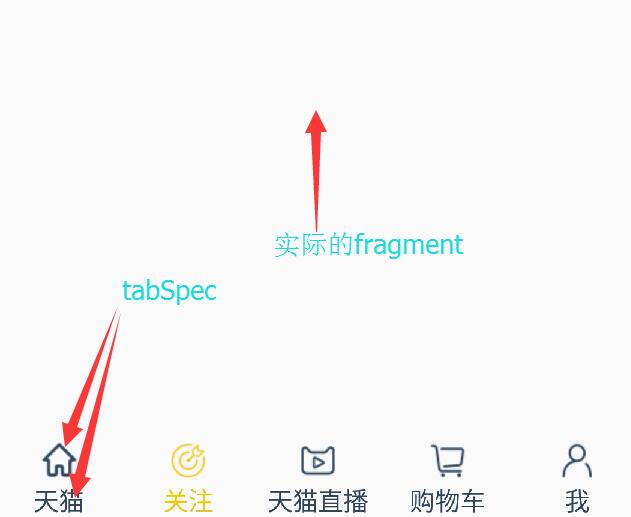1.首先创建一个Activity继承自FragmentActivity和与之匹配的layout
<?xml version="1.0" encoding="utf-8"?>
<LinearLayout xmlns:android="http://schemas.android.com/apk/res/android"
android:orientation="vertical"
android:layout_width="match_parent"
android:layout_height="match_parent">
<!--这里是真正的fragment-->
<FrameLayout
android:id="@+id/realtabcontent"
android:layout_width="fill_parent"
android:layout_height="0dip"
android:layout_weight="1" />
<!--这里的id是固定的 详情可以看我前面关于TabHost的文章-->
<android.support.v4.app.FragmentTabHost
android:id="@android:id/tabhost"
android:layout_height="wrap_content"
android:layout_width="match_parent">
<!--这里是假的fragment 不使用他-->
<!--这里的id是固定的 详情可以看我前面关于TabHost的文章-->
<FrameLayout
android:id="@android:id/tabcontent"
android:layout_width="0dp"
android:layout_height="0dp"
android:layout_weight="0" />
</android.support.v4.app.FragmentTabHost>
</LinearLayout>FragmentActivity里的操作步骤
1.实例化fragmenttabhost
fragmentTabHost = (FragmentTabHost) findViewById(android.R.id.tabhost);
2.这里是与tab同步切换的实际fragment
fragmentTabHost.setup(this, getSupportFragmentManager(), R.id.realtabcontent);
3.创建以标题为参数的 tabSpec对象
TabHost.TabSpec tabSpec = fragmentTabHost.newTabSpec(标题);
4.设置tabSpec的视图
layoutInflater = LayoutInflater.from(this);
View view = layoutInflater.inflate(R.layout.tab_indicator, null);
textView = (TextView) view.findViewById(R.id.txt_indicator);
imageView = (ImageView) view.findViewById(R.id.icon_tab);
textView.setText(tabBean.getTitle());
imageView.setImageResource(tabBean.getIcon());
tabSpec.setIndicator(view);
5.添加实际tabSpec和与之对应的Fragment
fragmentTabHost.addTab(tabSpec, fragment.class, null);
然后我们要自己写与之对应的fragment
这个就不多讲了 后面会贴出代码
代码区
HomeActivity.java pers.xxxxx.tianmao.ui.activity;
public class HomeActivity extends FragmentActivity {
private FragmentTabHost fragmentTabHost;
private LayoutInflater layoutInflater;
private TextView textView;
private ImageView imageView;
private List<TabBean> list = new ArrayList<>(5);
@Override
protected void onCreate(Bundle savedInstanceState) {
super.onCreate(savedInstanceState);
setContentView(R.layout.layout_loading);
initTab();
}
private void initTab() {
//初始化list
TabBean tab_home = new TabBean(HomeFragment.class, R.drawable.selector_icon_home, R.string.home);
TabBean tab_care = new TabBean(HotFragment.class, R.drawable.selector_icon_care, R.string.care);
TabBean tab_tmzb = new TabBean(CategoryFragment.class, R.drawable.selector_icon_tmzb, R.string.tmzb);
TabBean tab_cart = new TabBean(CartFragment.class, R.drawable.selector_icon_cart, R.string.cart);
TabBean tab_mine = new TabBean(MineFragment.class, R.drawable.selector_icon_mine, R.string.mine);
list.add(tab_home);
list.add(tab_care);
list.add(tab_tmzb);
list.add(tab_cart);
list.add(tab_mine);
//实例化fragmenttabhost
fragmentTabHost = (FragmentTabHost) findViewById(android.R.id.tabhost);
// 这里是与tab同步切换的实际fragment
fragmentTabHost.setup(this, getSupportFragmentManager(), R.id.realtabcontent);
for (TabBean tabBean : list) {
//标题
TabHost.TabSpec tabSpec = fragmentTabHost.newTabSpec(String.valueOf(tabBean.getTitle()));
//消除分割线
fragmentTabHost.getTabWidget().setShowDividers(LinearLayout.SHOW_DIVIDER_NONE);
layoutInflater = LayoutInflater.from(this);
View view = layoutInflater.inflate(R.layout.tab_indicator, null);
textView = (TextView) view.findViewById(R.id.txt_indicator);
imageView = (ImageView) view.findViewById(R.id.icon_tab);
textView.setText(tabBean.getTitle());
imageView.setImageResource(tabBean.getIcon());
tabSpec.setIndicator(view);
fragmentTabHost.addTab(tabSpec, tabBean.getFragment(), null);
}
}
}
TabBean.java pers.lijunxue.tianmao.ui.javabean;
public class TabBean {
private int title; //每个图片按钮的一个标志
private int icon; //图片
private Class fragment; //必须加载的fragment,类似于HomeFragment
public TabBean(Class fragment, int icon, int title)
{ this.fragment = fragment;
this.icon = icon;
this.title = title;
}
public int getIcon()
{
return icon;
}
public void setIcon(int icon)
{
this.icon = icon;
}
public int getTitle()
{
return title;
}
public void setTitle(int title)
{
this.title = title;
}
public Class getFragment()
{
return fragment;
}
public void setFragment(Class fragment)
{
this.fragment = fragment;
}
}selector_icon_care.xml 举一个例子 其他几个都一样的
<?xml version="1.0" encoding="utf-8"?>
<selector xmlns:android="http://schemas.android.com/apk/res/android">
<!-- Non focused states -->
<item android:state_focused="false" android:state_selected="false" android:state_pressed="false" android:drawable="@mipmap/icon_care_n" />
<item android:state_focused="false" android:state_selected="true" android:state_pressed="false" android:drawable="@mipmap/icon_care_press" />
<!-- Focused states -->
<item android:state_focused="true" android:state_selected="false" android:state_pressed="false" android:drawable="@mipmap/icon_care_press" />
<item android:state_focused="true" android:state_selected="true" android:state_pressed="false" android:drawable="@mipmap/icon_care_press" />
<!-- Pressed -->
<item android:state_selected="true" android:state_pressed="true" android:drawable="@mipmap/icon_care_press" />
<item android:state_pressed="true" android:drawable="@mipmap/icon_care_press" />
</selector>大家还记得上面有这样一句代码吧layoutInflater.inflate(R.layout.tab_indicator, null);
tab_indicator.xml
<!--这个布局是fragmentTabHost中一个按钮的布局-->
<LinearLayout xmlns:android="http://schemas.android.com/apk/res/android"
android:orientation="vertical"
android:layout_width="match_parent"
android:layout_height="match_parent"
android:layout_gravity="center"
android:paddingTop="3dp"
android:paddingBottom="3dp"
android:gravity="center">
<ImageView
android:id="@+id/icon_tab"
android:layout_width="wrap_content"
android:layout_height="wrap_content"
/>
<TextView
android:id="@+id/txt_indicator"
android:layout_width="wrap_content"
android:layout_height="wrap_content"
android:layout_marginTop="2dp"
android:textColor="@color/selector_tab_text"
/>
</LinearLayout>fragment 空白的类 同学们可以自己添加view
public class HomeFragment extends Fragment {
@Nullable
@Override
public View onCreateView(LayoutInflater inflater, @Nullable ViewGroup container, @Nullable Bundle savedInstanceState) {
View view = inflater.inflate(R.layout.fragment_home, container, false);
return view;
}
}





















 357
357











 被折叠的 条评论
为什么被折叠?
被折叠的 条评论
为什么被折叠?








